| 20 March |
• yesterday • tomorrow |
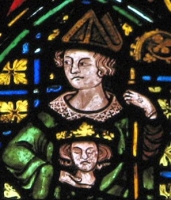
• Thaumaturgus of England
• Wonder-Worker of England
Orphaned at an early age. Shepherd. Received a vision of Saint Aidan of Lindesfarne entering heaven; the sight led Cuthbert to become a Benedictine monk at age 17 at the monastery of Melrose, which had been founded by Saint Aidan. Guest-master at Melrose where he was know for his charity to poor travellers; legend says that he once entertained an angel disguised as a beggar. Spiritual student of Saint Boswell. Prior of Melrose in 664.
Due to a dispute over liturgical practice, Cuthbert and other monks abandoned Melrose for Lindisfarne. There he worked with Saint Eata. Prior and then abbot of Lindesfarne until 676. Hermit on the Farnes Islands. Bishop of Hexham, England. Bishop of Lindesfarne in 685. Friend of Saint Ebbe the Elder. Worked with plague victims in 685. Noted (miraculous) healer. Had the gift of prophecy.
Evangelist in his diocese, often to the discomfort of local authorities both secular and ecclesiastical. Presided over his abbey and his diocese during the time when Roman rites were supplanting the Celtic, and all the churches in the British Isles were brought under a single authority.
634 somewhere in the British Isles
• 20 March 687 at Lindesfarne, England of natural causes
• interred with the head of Saint Oswald, which was buried with him for safe keeping
• body removed to Durham Cathedral at Lindesfarne in 1104
• his body, and the head of Saint Oswald, were incorrupt
• eagles
• bishop accompanied by swans and otters
• bishop holding the crowned head of Saint Oswald
• hermit with tau staff being fed by an eagle
• incorrupt body being found with a chalice on his breast
• man praying by the sea
• man rebuilding a hut and driving out devils
• man rebuking crows
• man tended by eagles
• man tended by swans
• man tended by sea otters
• man with a Benedictine monk kissing his feet
• man with pillars of light above him
• against plague and epidemics
• boatmen, mariners, sailors, watermen
• shepherds
• England
• Hexham and Newcastle, England, diocese of
• Lancaster, England, diocese of
• Durham, England
• Northumbria, England
According to F. Cashier, the swan is chiefly assigned to this saint, for this bird has been chosen as an emblem of men who are particularly attached to a solitary life, since it is generally very silent. However, we are inclined to think that the bird here mentioned was the downy goose, and not the swan.
Let us judge from what M. de Montalembert says, "They used to swarm on the rock (of Lindisfarne) in former days, and are still found there, though in much smaller numbers, on account of the people who come and steal their nests and shoot them. These birds were found nowhere else in the British Isles, and were called the birds of Saint Cuthbert. It is he who, according to a monk of the thirteenth century, inspired their hereditary confidence because he took them for companions of his solitude, and was careful that no one should disturb them in their habits." - from "The Little Bollandists" by Monsignor Paul Guérin, 1882
https://catholicsaints.info/saint-cuthbert-of-lindisfarne/
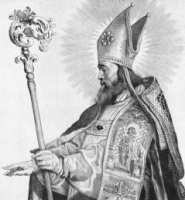
• Wulfram of Fontenelle
• Offran, Oufran, Suffrain, Vuilfran, Vulfran, Vulfranno, Vulphran, Wilfranus, Wolfram, Wolframus, Wolfran, Wulframnus, Wulfran, Wulfrann, Wulfrannus
• 15 October (translation of relics)
• 8 November as one of the Saints of the Diocese of Evry
Son of an official in the court of King Dagobert. Courtier under Clotaire III. Priest. Benedictine. Archbishop of Sens, France in 682, but in 685 he surrendered his see to Saint Amatus, whom he felt was the rightful bishop. Gave away his lands and evangelized the Frisians in Scandanavia with a group of monks for twenty years, remembered there as the Christian crew who "bore the White Christ" to these people.
Converted the son of King Radbod, and was allowed to preach the Gospel. He met with some success, but it was a rough and pagan land. children were sacrificed to heathen gods by hanging or drowning in the sea; people would cast lots at festivals to pick a victim, and the loser was immediately hanged or cut to pieces. Wulfram appealed to King Radbod to stop the slaughter, but the king said it was their custom, and he could not change it. He challenged Wulfram to rescue the victims if he could; Wulfram then waded into the sea to save two children who had been tied to posts and left to die in the rising tide.
The turning point in the mission came with the rescue of Ovon. Ovon had been picked by lot to be sacrificed by hanging. Wulfram begged King Radbod to stop the killing, but the commoners were outraged at the sacrilege. Wulfram eventually obtained an agreement that if Wulfram's God saved Ovon's life, Wulfram and the God could have the man. Ovon was hanged, and swung from the rope for two hours, during which Wulfram prayed. When the heathens decided to leave Ovon for dead, the rope broke, Ovon fell - and was alive. Ovon became Wulfram's slave, his follower, a monk, and then a priest at Fontenelle. The faith of the missionaries (and their power to work miracles), frightened and awed the people who turned from their old ways, and were baptized.
Even King Radbod converted, but just before his baptism, Radbod asked where his ancestors were. Wulfram told him that idolators went to hell. "I will go to hell with my ancestors," said the King, "rather than be in heaven without them." Later, near death, Radbod sent for Saint Willibrord to baptize him, but died before the saint's arrival.
Wulfram's relics were translated from Fontenelle to Abbeville, and in 1062, they were moved to Rouen, France. The life of Wulfram was written by the monk Jonas of Fontenelle eleven years after his death.
c.640; French
• 20 March 703 at Fontenelle, France of natural causes
• relics at Abbeville, France
• Abbeville, France
• against the dangers of the sea
• man baptizing a young king
• cleric with a young king nearby
• cleric arriving by ship with monks and baptizing a king
• baptizing the son of King Radbod
To the ship's bow he ascended,
By his choristers attended,
Round him were the tapers lighted,
And the sacred incense rose.
On the bow stood Bishop Sigurd,
In his robes as one transfigured,
And the Crucifix he planted.
- from The Saga of King Olaf by Longfellow, concerning Wulfram's voyage
https://catholicsaints.info/saint-wulfram-of-sens/
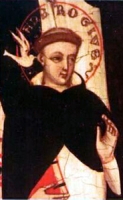
• Ambrogio Sansedoni
• Ambrose Sansedone
The son of a book illuminator, he was born so badly deformed that his mother gave him off to the care of a nurse. The nurse claimed that the only time the child was peaceful was in the local Dominican church, especially when near the altar of relics. Legend says that one day in church, the nurse covered the baby's face with a scarf; an unknown pilgrim told her, "Do not cover that child's face. He will one day be the glory of this city." A few days later the child suddenly stretch out his twisted limbs, pronounced the name "Jesus", and all deformity left him.
A pious child, getting up during the nights to pray and meditate. At age two he was given the choice of two of his father's books - and chose the one about saints. From age seven he daily recited the Little Office of the Blessed Virgin. He was always charitable, and even when young he worked with the poor, the abandoned, and the sick.
When he announced he wanted to join the preaching friars, his parents and friends tried to talk him out of it. But Ambrose had heard the call, and he joined the Dominicans in Siena, Italy in 1237 on his 17th birthday.
He studied in Paris, France, and Cologne, Germany with Saint Thomas Aquinas and Pope Blessed Innocent V under Saint Albert the Great. Taught in Cologne. Ambrose wanted to write, but saw the greatness of Saint Thomas, decided he could not match it, and devoted himself to preaching.
Worked on diplomatic missions for popes and secular rulers. Evangelized in Germany, France, and Italy; his preaching helped lead Blessed Franco of Siena to the solitary life. Mystic with a deep contemplative prayer life. He received ecstacies and visions, was known to levitate when preaching, and was seen circled in a mystic light in which flew bright birds.
16 April 1220 at Siena, Italy
20 March 1287 at Siena, Italy of natural causes
8 October 1622 by Pope Gregory XV (cultus confirmed)
• affianced couples
• betrothed couples
• engaged couples
• Siena, Italy
• Dominican preaching
• Dominican holding a book
• Dominican holding a model of Siena, Italy
• Dominican with a dove at his ear
Merciful God, may this feast of Blessed Ambrose bring joy to the Church, that she may be strengthened with spiritual help and be made worthy to enjoy everlasting happiness. We ask this through our Lord Jesus Christ, your Son, who lives and reigns with you and the Holy Spirit, one God, for ever and ever. - General Calendar of the Order of Preachers
https://catholicsaints.info/blessed-ambrose-sansedoni-of-siena/
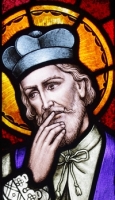
• Jan Nepomucký
• John Nepomucen
• John of Nepomuk
• John Wolflin
• Johannes von Nepomuk
• Martyr of the Confessional
While a child, he was cured by the prayers of his parents; they then consecrated him to God. Priest. Known as a great preacher who converted thousands. Vicar-general of Prague (in the modern Czech Republic). Counselor and advocate of the poor in the court of King Wenceslaus IV. He refused several bishoprics. Confessor to the queen, he taught her to bear the cross of her ill-tempered husband the king. Imprisoned for refusing to disclose the queen's confession to the king. When he continued to honor the seal of the confessional, he was ordered executed. Symbol of Bohemian nationalism. His image has been used in art as a symbol of the sacrament of Confession, and many bridges in Europe bear his likeness as their protector.
c.1340 at Nepomuk, Bohemia (in modern Czech Republic) as John Wolflin
• burned, then tied to a wheel and thrown off a bridge into the Moldau River (in the modern Czech Republic) to drown on 20 March 1393
• on the night of his death, seven stars hovered over the place where he drowned
19 March 1729 by Pope Benedict XIII
• against calumnies or slander
• against floods
• against indiscretions
• bridges and bridge builders
• canons
• confessors and for a good confession
• for discretion and silence
• mariners, sailors, boatmen, watermen
• running water
• Bohemia
• Czech Republic
• archdiocese of Prague, Czech Republic
• Venice, Italy
• priest with a halo made of seven stars
• priest with his finger to his lips or otherwise indicating silence
https://catholicsaints.info/saint-john-nepomucene/
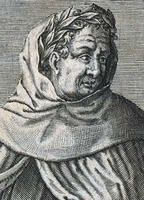
• Baptista Mantuanus
• Baptista Spagnoli
• Baptista Spagnolo
• Baptista Spagnuoli Mantuanus
• Baptista Spanuoli Mantuanus
• Baptistae Mantuani
• Battista Spagnoli
• Battista Spagnuoli
• Giovanni Baptista Mantuanus
• Johannes Baptista Mantuanus
• Mantuan
• Mantuanus
• Mantuanus Baptista
Son of Peter Spagnoli, a Spanish nobleman assigned to the court in Mantua, Italy. Studied in Padua, Italy where a wild life put him briefly at the mercy of loan sharks, and got him thrown out of his father's house. Drifted through Venice, Italy. Experienced a conversion to the faithCarmelite at age 16 at Ferrara, Italy. Elected vicar-general of his congregation six times. Prior-general of the Carmelites in 1513. Noted poet, writing over 55,000 lines of Latin verse; has been criticized for excessive use of pagan mythological images in his work, but was referred to as the Good old Mantuan by Shakespeare in Love's Labour Lost. Eminent representative of Italian Christian Humanism.
17 April 1447 at Mantua, Italy
20 March 1516 at Mantua, Italy of natural causes
1890 by Pope Leo XIII
https://catholicsaints.info/blessed-john-baptist-spagnuolo/
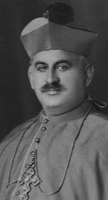
Vinçenc
Nikollë entered the Franciscan Friars Minor in 1900, taking the name Vinçenc, and made his profession at Salzburg, Austria on 12 December 1904. He studied theology and philosophy in Innsbruck, Austria, and was ordained a priest in Salzburg on 19 March 1908. He wrote, poetry, books and articles for newspapers and magazines on political and international topics, and collected Albanian folklore. Chosen bishop of Sapë, Albania by Pope Pius XI on 27 February 1936. Chosen archbishop of Durrës, Alabania by Pope Pius XII on 26 June 1940. Arrested by Communist authorities on 19 May 1947 and sentenced to 20 years in prison for the crime of staying loyal to Rome and not turning everything over the national church formed by the Communists. After a show trial, he was sentenced to prison where he was tortured, abused and neglected to death. Martyr.
4 September 1885 in Shkodrë, Albania
20 March 1949 in prison in Durrës, Albania of abuse and repeated torture
• 5 November 2016 by Pope Francis
• beatification celebrated at the Square of the Cathedral of Shën Shtjefnit, Shkodër, Albania, presided by Cardinal Angelo Amato
https://catholicsaints.info/blessed-nikolle-prennushi/
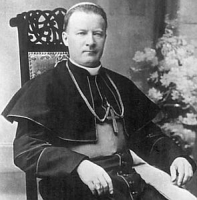
• Giuseppe Bilczewski
• Joseph Bilczewski
• Jozef Bilczewski
• Yosyp Bil'chevs'kyi
Eldest of nine children in a peasant family. Seminarian at Krakow, Poland. Ordained on 6 July 1884. Doctor of theology at the University of Vienna, Austria in 1886. Studied dogmatic theology and Christian archaeology in Rome, Italy and Paris, France. Professor of theology at the University of Lviv in 1891. Archbishop of Leopoli, Ukraine on 17 December 1900. Often intervened with civil authorities on behalf of Poles, Ukrainians and Jews. Guided his flock during World War I (1914 to 1918), the Polish-Ukrainian War (1918-1919), the Bolshevik invasion (1919-1920), and the anti-Catholic terror started by the Communists; from 1918-1921 his archdiocese lost about 120 priests. Fought to protect everyone in his see, regardless of race or religion.
26 April 1860 at Wilamowice, Austria (modern Ukraine)
20 March 1923 at Lviv, Ukraine of pernicious anemia
23 October 2005 by Pope Benedict XVI at Rome, Italy
https://catholicsaints.info/saint-josef-bilczewski/
Daniele
Born to the Carinthian nobility, Daniele became a wealthy fabric merchant. Married to Orsina Ricchieri, the two had a daughter named Lucia. Daniel became a judge, and throughout his life he worked in politics and served in civil offices.
Though he travelled in wordly circles, Daniel was known as a spiritual and charitable man. In the area of Venice, Italy, he met, befriended, stayed with, and came to admire the Camaldolese monks of the San Mattia monastery in the Murano area. He was so impressed by them and their spirituality that he became a Cistercian oblate attached to the house, living next to the monastery for over 20 years, continuing his business, and spending his off time devoted to his spiritual life.
1344 at the Ungrispach castle in the duchy of Carinthia (in modern Cormons, Italy)
• strangled to death in his sleep in 1411 near the San Mattia monastery in the area of Murano, Italy
• buried at the monastery of San Mattia in Murano
• in 1435 his body was found to be incorrupt; legend says the whole Murano area was filled with the odor of flowers when his tomb was opened
• re-interred in a glass coffin in the basilica of Saints Mary and Donatus in Murano, Italy
https://catholicsaints.info/blessed-daniel-of-ungrispach/
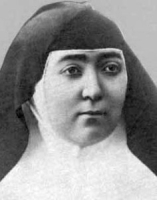
• Maria Josefa of the Heart of Jesus
• Maria Giuseppina del Cuore di Gesù
Nun, joining the Institute of the Servants of Mary at age 18, taking name Maria Josefa of the Heart of Mary. Helped found the Institute of the Servants of Jesus in Bilbao, Spain in 1871; the Institute sisters care for the children, the sick, the elderly and the abandoned in hospital and in their homes. By her death, the Insitute had 43 houses and 1,000 sisters; they continue their good work today with 100 houses in 16 countries.
7 September 1842 in Vitoria, Basque Country, Spain
20 March 1912 in Bilbao, Vizcaya, Spain of natural causes
1 October 2000 by Pope John Paul II
https://catholicsaints.info/saint-maria-josefa-sancho-de-guerra/
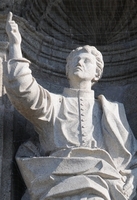
• Martin of Dumio
• Martin of Panónia
• Martin of Dume
• Martin Bracarense
• Martin Dumiense
• Martinho...
Monk in Palestine. In 550 he introduces communal monasticism into Galatia in Spain. Abbot at the Dumio Monastry in Dume, Portugal and missionary to the Arians and pagans of the area by May 561. Bishop of Mondoñedo, Spain. Archbishop of Braga, Portugal by 572. Writer who left text of his homilies and sermons, and moral, liturgical, and ascetical treatises.
515-520 at Pannonia
580 at Braga, Portugal of natural causes
• Braga, Portugal, archdiocese of
• Braga, Portugal, city of
https://catholicsaints.info/saint-martin-of-braga/
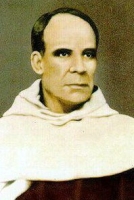
• Francisco Palau y Quer
• Francesc Palau Quer
• Francesc of Jesus, Mary, Joseph
Joined the Carmelites in 1832. Ordained in 1836. Civil disorder forced him into exile. He returned to Spain in 1851 and founded his School of Virtue at Barcelona to teach catechism. For non-theological reasons, his school was suppressed and he was exiled to Ibiza from 1854 to 1860. Founded the Congregation of Carmelite Brothers and Congregation of Carmelite Sisters in 1860-1861 in the Balearic Islands. Preached popular missions and devotion to Our Lady.
29 December 1811 at Aythona, Lerida, Spain
20 March 1872 at Tarragona, Spain of natural causes
24 April 1988 by Pope John Paul II
https://catholicsaints.info/blessed-francis-palau-y-quer/
Benedictine monk and priest. Disciple and friend of Saint Cuthbert of Lindisfarne. Hermit on the island of Lake Derwentwater, later called Saint Herbert's Island. Each year he visited Cuthbert at Lindisfarne. In 686 Cuthbert visited Herbert on his island, and told him that if he had anything to ask, he must do so because he foresaw he would soon die. They both prayed they go together. Soon after, Herbert fell ill; the illness lasted till 20 March 687 when both saints died. In 1374, Bishop Thomas Appleby of Carlisle ordered the vicar of Crosthwaite to celebrate a sun Mass on Saint Herbert's Isle each year on his feast, and granted 40 days Indulgence to all who visited on this day. Ruins of a circular stone building there may be connected with him.
20 March 687 of natural causes
https://catholicsaints.info/saint-herbert-of-derwentwater/
• Clemens Scotus
• Clement of the Paris Schools
Clement and his companion Ailbe, arrived in Gaul in 772, and opened shop as teachers. Their fame spread, and Charlemagne sent for them to come to his court, where they stayed for several months. Ailbe was given direction of a monastery near Pavia, Italy. Clement stayed in France as regent of the Paris school from 775 until his death. Legend says that Clement founded the University of Paris, which in a metaphorical sense he did since he started a great tradition of learning in the city.
c.750 in Ireland
• 20 March 818 in Auxerre, France of natural causes
• interred in the church of Saint-Amator
https://catholicsaints.info/saint-clement-of-ireland/
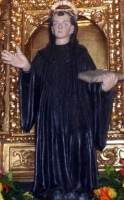
Guglielmo, William
Benedictine monk in Sahagún, León, Spain. He and his brother monks fled from there ahead of invading Saracens, and settled in Peñacorada mountains outisde Cistierna, Spain. There they built the monastery of Santa Maria de los Valles, and Guillermo served as abbot; the house was later renamed San Guillermo de Peñacorada in his honour.
Spain
c.1042 of natural causes
Cistierna, Spain
https://catholicsaints.info/saint-guillermo-de-penacorada/
• Eberhard of Einberg
• Eberhardus, Eberardus, Ebrardus, Évrard
Born to the nobility, the Count of Mons in modern Belgium. After fighting as a soldier and commander for Limburg in a war against Brabant, he went on pilgrimage to Rome, Italy and Compostella, Spain in penance. Wishing to withdraw from the world, he became a swineherd for the Cistercian abbey of Morimond in Parnoy-en-Bassigny, France. When the brothers there discovered his identity and story, they accepted him as a brother monk. In 1142, Brother Eberhard founded houses in Einberg and the Mont-Saint-George.
c.1150 of natural causes
https://catholicsaints.info/blessed-eberhard-of-mons/

Archippus the Apostle
• 19 February (with Philemon and Appia)
• 6 July (with Onesimus)
• 22 November (with Philemon and Appia)
Companion of Saint Paul the Apostle. Tradition says he was one of the 72 disciples. In the canonical Epistle to the Colossians, Paul bids him "take heed to the ministry which thou hast received in the Lord, that thou fulfill it."
possibly at Colossae or Laodicea; records vary
1st century
https://catholicsaints.info/saint-archippus-of-colossi/
Adalbert joined the Premonstratensians in 1650. Canon of the monastery in Tongerlo (in modern Belgium), and later served as zirkator, a monk to supervises the observance of monastic discipline. Chaplain of the house in Alphen. Novice master at Tongerlo from 1662 to 1682. In all these offices he emphasized obedience to their Rule and to their superiors as aids in the search of the brothers for God.
1629 in Meerhout, Antwerp, Flanders (in modern Belgium)
• 1683 of natural causes
• his desk, crucifix and writings were preserved in the monastery in dedication to him
https://catholicsaints.info/blessed-adalbert-vos/
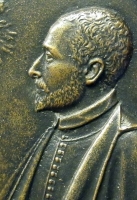
Ippolito Galantini
Silk-weaver. From age twelve, he assisted priests in teaching children their catechism. As an adult, he formed the congregation of Italian Doctrinarians, who taught children catechism.
1565 at Florence, Italy
1619 of natural causes
29 June 1825 by Pope Leo XII
https://catholicsaints.info/blessed-hippolytus-galantini/
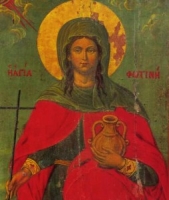
• Photina the Samaritan
• Fotina...
Martyred in the persecutions of Nero. One tradition says that she was the woman that Jesus talked to at Jacob's well (John 4).
in Rome, Italy
https://catholicsaints.info/saint-photina-of-rome/
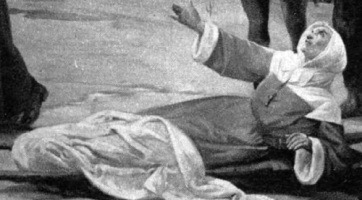
21 January as one of the Blessed Martyrs of Laval
Member of the Sisters of Charity of Our Lady of Evron. Martyred in the French Revolution.
6 August 1766 in Quelaines, Mayenne, France
20 March 1794 in Laval, Mayenne, France
19 June 1955 by Pope Pius XII at Rome, Italy
https://catholicsaints.info/blessed-jeanne-veron/
John of Mar Sabas
Monk at the eremetical abbey (a laura) of Saint Sabas' near Jerusalem. Martyred with 20 other monks in an Arab anti-Christian raid during which many others were injured but escaped; one of them, named Stephen, wrote a poem in honour of the group known as the Martyrs of Mar Sabas.
martyred in 796
https://catholicsaints.info/saint-john-sergius/

• Alexandra of Samsun
• Alessandra
Christian woman martyred in the persecutions of Diocletian.
burned to death c.300 in Amisus, Paphlagonia (modern Samsun, Turkey)
https://catholicsaints.info/saint-alexandra-of-amisus/
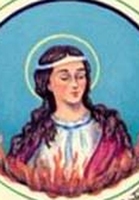
Claudia
Christian woman martyred in the persecutions of Diocletian.
burned to death c.300 at Amisus, Paphlagonia (in modern Turkey)
https://catholicsaints.info/saint-caldia-of-amisus/
Remi, Remidius
Born to the nobility, the son of Hugh of Alsace; cousin of Saint Odilia of Hohenburg. Abbot of Münster near Colmar, France. Bishop of Strasbourg, France in 776.
783
https://catholicsaints.info/saint-remigius-of-strasbourg/
• Anastasius of Jerusalem
• Anastasius of Saint Sabas
Monk. Archimandrite of Saint Sabas Abbey in Jerusalem. Murdered with his brothers in an attack by a band of thieves.
797
https://catholicsaints.info/saint-anastasius-xvi/
• Nicetas of Bithynia
• Niceta
Bishop of Apollonias in Bithynia (in modern Turkey). Persecuted and exiled to Anatolia for opposing the iconoclasm of emperor Leo III.
https://catholicsaints.info/saint-nicetas-of-apollonias/
Urbicio
Bishop of Metz, France. Built a church in honour of Saint Felix of Nola; it became part of the Saint Clement monastery.
c.420
https://catholicsaints.info/saint-urbitius-of-metz/
Twenty monks who were martyred together in their monastery by invading Saracens.
797 when they were burned inside the San Sabas monastery in Palestine
https://catholicsaints.info/martyrs-of-san-sabas/
Christian woman martyred in the persecutions of Diocletian.
burned to death c.300 at Amisus, Paphlagonia (in modern Turkey)
https://catholicsaints.info/saint-euphrasia-of-amisus/
Christian woman martyred in the persecutions of Diocletian.
burned to death c.300 at Amisus, Paphlagonia (in modern Turkey)
http://catholicsaints.info/saint-theodosia-of-amisus/
Christian woman martyred in the persecutions of Diocletian.
burned to death c.300 at Amisus, Paphlagonia (in modern Turkey)
https://catholicsaints.info/saint-euphemia-of-amisus/
Christian woman martyred in the persecutions of Diocletian.
burned to death c.300 at Amisus, Paphlagonia (in modern Turkey)
http://catholicsaints.info/saint-derphuta-of-amisus/
Christian woman martyred in the persecutions of Diocletian.
burned to death c.300 at Amisus, Paphlagonia (in modern Turkey)
http://catholicsaints.info/saint-juliana-of-amisus/
Christian woman martyred in the persecutions of Diocletian.
burned to death c.300 at Amisus, Paphlagonia (in modern Turkey)
http://catholicsaints.info/saint-matrona-of-amisus/
Son of Saint Gregory of Langres; uncle of Saint Gregory of Tours. Bishop of Langres, France c.540.
572
https://catholicsaints.info/saint-tertricus-of-langres/
Ulfino, Vilfino, Vilphin, Vulfino, Vulfinus
Bishop of Die, France in the late 8th and early 9th centuries.
https://catholicsaints.info/saint-vilfinus-of-die/
Benignus of Fontenelle
Monk and abbot at Fontenelle and Flay in France.
725
https://catholicsaints.info/saint-benignus-of-flay/
Bishop of Rath-derthaighe, Ireland.
https://catholicsaints.info/saint-cathcan-of-rath-derthaighe/
A group of Christians martyred together in the persecutions of Nero. We know nothing else about them but the names Anatolius, Cyriaca, Joseph, Parasceve, Photis, Photius, Sebastian and Victor.
A group of Christians who were martyred together in Syria. We know nothing else about them but the names Cyril, Eugene and Paul.
• Eithene
• Mauritius Csák of Hungary
• Michel Carnano
• Our Lady of Calevourt
CatholicSaints.Info Portable Edition